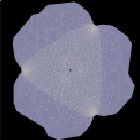The spectral curve for for a
Discrete Conformal Map
Let ![]() be the ordered points
be the ordered points ![]() .
We think of this as the initial discrete curve. If we choose any point
.
We think of this as the initial discrete curve. If we choose any point
![]() on
on ![]() not on
not on ![]() then for fixed cross-ratio q there is a
unique point
then for fixed cross-ratio q there is a
unique point ![]() for which
for which
![]()
Inductively we define ![]() by requiring
by requiring
![]()
Clearly these points are given by iterating the Mobius transformations ![]() uniquely
determined by the condition that for all points
uniquely
determined by the condition that for all points ![]()
![]()
Thus ![]() generates another discrete curve
generates another discrete curve ![]() . This will also be
periodic of period n when
. This will also be
periodic of period n when ![]() . Since
. Since ![]() this means the first point
this means the first point ![]() must be an eigenline of the "holonomy"
must be an eigenline of the "holonomy"
![]()
It is easy to show that the transformation ![]() can be represented by a
can be represented by a
![]() matrix of the form
matrix of the form ![]() where
where ![]() is a projection matrix.
Therefore if we allow q to vary over all complex values (and rename it
is a projection matrix.
Therefore if we allow q to vary over all complex values (and rename it ![]() )
we can represent the family of all holonomies by a matrix valued polynomial
)
we can represent the family of all holonomies by a matrix valued polynomial
![]() in
in ![]() . The spectral curve is essentially the
characteristic polynomial of this matrix. The important point, which is
not obvious, is that this curve is independent of the point
. The spectral curve is essentially the
characteristic polynomial of this matrix. The important point, which is
not obvious, is that this curve is independent of the point ![]() at which the
holonomy is based (it can be shown that a change of base point amounts to
a conjugation of the holonomy matrix, hence its charateristic polynomial remains invariant).
at which the
holonomy is based (it can be shown that a change of base point amounts to
a conjugation of the holonomy matrix, hence its charateristic polynomial remains invariant).
Each point ![]() itself is an eigenline of the holonomy matrix
itself is an eigenline of the holonomy matrix
![]() for
for ![]() . The family of all eigenlines for
fixed k,m as
. The family of all eigenlines for
fixed k,m as ![]() varies gives a line bundle over the spectral curve.
This line bundle changes with k and m in an essentially elementary way:
it is determined by a map from
varies gives a line bundle over the spectral curve.
This line bundle changes with k and m in an essentially elementary way:
it is determined by a map from ![]() into the Jacobi variety of the spectral
curve which is either a group homomorphism or a zigzag (our term for a map which
is only a homomorphism on the subgroup of pairs (k,m) for which k+m is even).
We can provide a reconstruction of the discrete conformal map using
Riemann
into the Jacobi variety of the spectral
curve which is either a group homomorphism or a zigzag (our term for a map which
is only a homomorphism on the subgroup of pairs (k,m) for which k+m is even).
We can provide a reconstruction of the discrete conformal map using
Riemann ![]() -functions to construct the appropriate sections of the moving
line bundle: the formulae are very like the well-known formulae for Baker-Akhiezer
functions in soliton theory, but the discrete versions have only poles instead
of essential singularities.
-functions to construct the appropriate sections of the moving
line bundle: the formulae are very like the well-known formulae for Baker-Akhiezer
functions in soliton theory, but the discrete versions have only poles instead
of essential singularities.
There is an elegant geometric connection between these discrete maps and their smooth cousins in soliton theory. In the sense of Capel and Nijhoff the constant cross-ratio equation is the discrete analogue of the Schwarzian KdV equation
![]()
where ![]() is the Schwarzian
derivative of z. This equation is solvable by linearising the flow on the
Jacobi variety of a curve (Riemann surface). The line followed by the x-flow
is tangent to
the Abel image of the curve at a base point which must be an order two branch point for the
curve, while the t-flow follows the third order
osculating line to this point. The discrete dynamics are obtained
by replacing each of these with a secant to the curve: the location of the other
end of each secant determines the cross-ratio of the discrete
conformal map. It is interesting to note that the zigzag (which is the generic type of
solution) arises from splitting the base point into two (unbranched) points. This phenonmenon
has no analogue in the smooth theory.
is the Schwarzian
derivative of z. This equation is solvable by linearising the flow on the
Jacobi variety of a curve (Riemann surface). The line followed by the x-flow
is tangent to
the Abel image of the curve at a base point which must be an order two branch point for the
curve, while the t-flow follows the third order
osculating line to this point. The discrete dynamics are obtained
by replacing each of these with a secant to the curve: the location of the other
end of each secant determines the cross-ratio of the discrete
conformal map. It is interesting to note that the zigzag (which is the generic type of
solution) arises from splitting the base point into two (unbranched) points. This phenonmenon
has no analogue in the smooth theory.
 |
 |
 |
 |
 |
![]() to Discrete Conformal Maps as
integrable systems
to Discrete Conformal Maps as
integrable systems